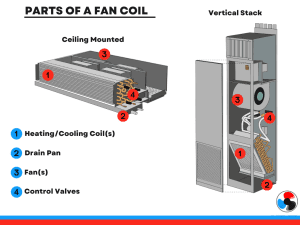Understanding Condo Fan Coil Units: How They Operate
Understanding Condo Fan Coil Units: How They Integrate with Building Systems
How Condo Fan Coil Units Operate:
Condo fan coil units are hydronic systems that utilize the building’s existing mechanical infrastructure to provide both chilled and heated water for climate control in condominiums. They are integral to managing heating and cooling in both low-rise and high-rise buildings and rely on several key components:
- Chiller: Cools the water used in the system.
- Boiler: Heats the water for distribution.
- Pump: Circulates the water through the system.
- Water Supply and Return Piping: Facilitates the flow of water to and from the fan coil units.
Advantages of Fan Coil Systems:
- Energy Efficiency:
- Choosing the right chiller and boiler can significantly reduce common area energy costs. Larger chillers can achieve cooling efficiencies of 16-21 EER (Energy Efficiency Ratio), which measures the amount of cooling provided per unit of energy consumed. Similarly, large natural gas boilers can reach efficiencies exceeding 90%.
- Comfort:
- Fan coil units excel in providing a quiet and highly controllable environment. They effectively manage temperature, humidity, and noise, enhancing overall in-home comfort.
- Service and Replacement:
- Fan coil systems are generally cost-effective, straightforward to maintain, and simple to replace when necessary. This makes them a practical choice for condo owners looking for reliable climate control.
- Energy Savings:
- These systems offer high efficiency and reliability while maintaining a manageable level of complexity. Their design allows for effective energy use, contributing to lower utility bills.
Why Choose Fan Coil Units:
Fan coil units stand out among in-suite HVAC options for their efficiency, comfort, and ease of maintenance. By leveraging the building’s central mechanical systems, they deliver consistent heating and cooling with minimal noise and maximum control, making them a smart choice for condo owners seeking optimal climate management.
How a Fan Coil Unit Operates:
A fan coil unit is straightforward in design, consisting of three primary components: a fan, a coil, and an actuated valve. Here’s a breakdown of its operation:
1. Key Components:
- Fan: Circulates air through the unit.
- Coil: Exchanges heat with the air, using either chilled or heated water.
- Actuated Valve: Controls the flow of water to the coil.
- Drain Pan: Collects any condensate from the coil during cooling.

2. Cooling Process:
- Thermostat Activation: When the thermostat signals a need for cooling, the valve opens to allow chilled water to flow through the coil.
- Air Cooling: The fan draws hot air from the room across the cold coil. The air is cooled to around 55 degrees Fahrenheit as it passes over the coil.
- Air Distribution: The cooled air is then distributed back into the room, lowering the overall temperature.
- Condensate Management: Any moisture that condenses on the cooling coil is collected in the drain pan and directed to a drain.
3. Heating Process:
- Heating Coil Options: For heating, the fan coil unit can use the same coil as for cooling (if it’s capable of heating), a separate hydronic heating coil, or an electric heating coil.
- System Activation: The system activates the appropriate coil based on the thermostat’s temperature setting, switching between cooling and heating as needed.
Summary:
The fan coil unit efficiently manages indoor climate by either cooling or heating the air. It maintains comfort through precise temperature control and effective moisture management, ensuring a consistent and pleasant environment in your spa
Choosing the Right Fan Coil Unit for Your Condo
Fan coil units come in various sizes to accommodate different space requirements. The most common sizes in condominium settings are:
- 3/4 Ton – 300 CFM (Cubic Feet per Minute)
- 1 Ton – 400 CFM
- 1 1/2 Ton – 600 CFM
- 2 Ton – 800 CFM
Optimizing Comfort and Efficiency
Fan coil units are valued for their versatility, energy efficiency, and ease of service. Their simple design allows for various installation options, including placement above ceilings, beneath windows, or in compact closets. This adaptability gives architects and developers the flexibility to integrate fan coils into their projects seamlessly.
2-Pipe vs. 4-Pipe Fan Coil Systems:
- 2-Pipe Systems:
- Design: This system uses a single set of supply and return pipes that alternate between cooling and heating modes.
- Benefits: Reduced initial construction costs due to fewer pipes and coils. This system is cost-effective for buildings where simultaneous heating and cooling are not required, as it operates in either cooling or heating mode at any given time.
- Drawbacks: The entire building must be in the same mode (either cooling or heating), which limits flexibility.
- 4-Pipe Systems:
- Design: Utilizes separate pipes for both heating and cooling, allowing simultaneous operation.
- Benefits: Provides the flexibility to heat and cool different areas of the building independently, enhancing comfort and efficiency.
- Drawbacks: Higher initial construction costs due to additional piping and more complex infrastructure.
Summary:
Fan coil units offer a range of options to meet diverse building needs, from varying sizes to different system configurations. Understanding the benefits of 2-pipe versus 4-pipe systems helps in making informed decisions based on project requirements and budget constraints.






